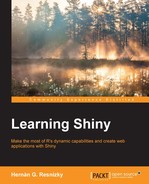In this section, table() and aggregate() will be covered. They are basic processing functions that come in the base package.
table(): This creates a contingency table with the specified vectors. Although its output is of the table type, it works similar to an array:sample.data <-data.frame(var1 =rep(c("Male","Female"),10), var2 =rep(c("A","B","C","D"))) example.table<-table(sample.data$var1, sample.data$var2) example.table ## ## A B C D ## Female 0 5 0 5 ## Male 5 0 5 0 example.table[2,2] ## [1] 0
The output of
table()can be indexed in the same way as an array.aggregate(): This performs one or more functions over a vector split by a factor variable.aggregate()has basically two ways of usage:- With vectors: One or more vectors are passed to the
xargument while one or more factor vectors are passed in thebyargument.FUNis the aggregation function to be used:> data(iris) > aggregate(iris$Sepal.Length, by=list(iris$Species), FUN="mean") Group.1 x 1 setosa 5.006 2 versicolor 5.936 3 virginica 6.588
- Through formula objects: Instead of specifying a vector and a
bylist, this information can be included in a formula object. Additionally, when using a formula object, it is not necessary to constantly refer to thedata.frameobject being used. In case the variables that are used come fromdata.frame, they can be specified in the data argument.With one factor, without the data argument:
> aggregate(iris$Sepal.Length ~ iris$Species, FUN="mean")With one factor, with the data argument:
aggregate(Sepal.Length ~Species, data = iris, FUN ="mean") ## Species Sepal.Length ## 1 setosa 5.006 ## 2 versicolor 5.936 ## 3 virginica 6.588
With two factors—as there is no other factor variable, a variable letter is added:
iris$letter <-LETTERS[1:5] aggregate(Sepal.Length ~Species +letter, data = iris, FUN ="mean") ## Species letter Sepal.Length ## 1 setosa A 5.16 ## 2 versicolor A 5.96 ## 3 virginica A 6.94 ## 4 setosa B 5.03 ## 5 versicolor B 6.11 ## 6 virginica B 6.28 ## 7 setosa C 4.85 ## 8 versicolor C 6.07 ## 9 virginica C 6.78 ## 10 setosa D 4.95 ## 11 versicolor D 5.82 ## 12 virginica D 6.44 ## 13 setosa E 5.04 ## 14 versicolor E 5.72 ## 15 virginica E 6.50
Compute the mean of all variables by species:
data(iris) aggregate(. ~Species, data = iris, FUN ="mean") ## Species Sepal.Length Sepal.Width Petal.Length Petal.Width ## 1 setosa 5.006 3.428 1.462 0.246 ## 2 versicolor 5.936 2.770 4.260 1.326 ## 3 virginica 6.588 2.974 5.552 2.026
Note
Formula objects are of the
x ~ yform where, inaggregate(),xis the vector over which the aggregation functions will be applied andyis the splitting factor. To combine the elements on the right-hand side, + is used. Formula objects are also very commonly used in modeling, wherexis the variable to model andyis the predictor. Lastly, if all variables should be included in one of the sides (except for the ones specified on the other side) they can be abbreviated with a dot.- With vectors: One or more vectors are passed to the
